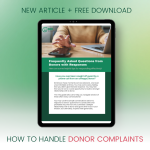Lessons on building trust and emotional connection with donors
So it might sound a bit strange, but I’d like to offer you some relationship advice… on how to build trust and engagement with your donors.
Because what your donors really want is to be heard, seen, known and remembered.
Quick disclaimer: Ashley, my lovely wife of 12 years, is a Marriage and Family Therapist (MFT). This is not something she readily volunteers when she meets people for the first time because some people can get skittish when they find out she’s a therapist!
As fundraisers, building trust and an emotional connection with our donors is the most fulfilling responsibility we have. So today we’ll be looking to my wife’s profession for a research-based approach to donor relationships – specifically, the concept of “bids” from noted psychologist Dr. John Gottman.
To keep it relevant, I’ll share plenty of real-life examples along the way, with overlap from BDI’s own in-house development guru and VP of BDI Academy, Shellie Speer. (And if you’re a BDI client, be sure to email Shellie for more about the benefits of BDI Academy that are included in our partnership!)
So let’s dive in…
First of all, let’s explain the concept of a “bid” and how it will be used in this context. To paraphrase the Gottman Institute, a bid is “any attempt… for attention, affirmation, affection, or any other positive connection.” Gottman’s groundbreaking notions about bids were a result of a 40-year-long journey to answer this question:
What separates the relationship masters from the relationship disasters?*
Before We Begin: Three Foundational Premises
In order to establish trust and a healthy relationship with your donors, here are three foundational premises that should already be in place at your organization.
- You must be curious and genuinely want to know your donor better.
If we are only treating donors transactionally – like they are an ATM and we expect regular withdrawals – they will know we aren’t interested in knowing them personally and don’t consider them a true partner. - You’re already regularly mixing organic engagement (testimonies, for example), prompt thank you receipts (within 72 hours preferred) and impact reporting into your annual fundraising strategy. The mix also includes regular engagement emails, newsletters, texts, handwritten notes, organic social media posts and phone calls.
If we are only asking for money – without sharing, thanking and reporting back on progress – we should not expect permission to go deeper with donors. - You deliberately turn off your phone when engaging with a donor. Being completely present honors your donor and is essential for trust and emotional connection.
If we show that we don’t value their time and attention – and don’t make them a priority – we can expect them to disregard our work and treat us with the same disinterest.
Bids are actions…
… and some donor bids for attention are more overt than others. For our purposes, we’ll focus on the more subtle bids that donors make for positive connection (using 8 of Gottman’s 14 minor bids, also found in his book, What Makes Love Last?):
1. Pay attention to what I say.
Sometimes even simple conversations can open the doorway to knowing a donor more deeply. An all-time favorite donor (and dear friend) had a cat with a peculiar name – the story behind the cat’s name was life-defining for my friend, and something I still remember to this day.
(And yes… that’s all I can share about that story. Remember, confidentiality is key in all relationships!)
2. Respond to simple requests.
Picking up a check/GIK from the home of an elderly donor is an all-time great donor bid, and a fantastic opportunity to get to know them better.
3. Show interest or excitement in my accomplishments.
An excellent MGO I know creates Google Alerts to track his well-known donors, so he can proactively reach out to congratulate them on good news. Research can be helpful in understanding a donor’s accomplishments… and once you know more about what they have done, you can often better predict their future behavior and motivations.
4. Answer my questions or request for info.
When a donor sees you as a resource for trustworthy information, they understand your nonprofit better and believe you are transparent and honest in all your communications.
Recently, a ministry featured a story in their newsletter about a graduate whose abrupt passing was in the news just as the newsletter was in-home. The development team’s honest, saddened response to donors helped to build trust and allow donors to more fully understand the ministry’s care for their graduates.
5. Chat with me. / Share the events of your day with me.
These two bids tie all the other bids together, and give you an opportunity to share as much personally as you are able/comfortable.
Consider adopting a simple phrase like “What’s new?” This allows others to expound as little – or as much – as they would like to help deepen and strengthen your relationship.
6. Help me de-stress. / Help me solve a problem.
These last two bids are combined because they can be disguised within a genuine and legitimate complaint, furthering interaction and engagement to meet their unique needs.
“You mail me too much!” is an important donor bid for a problem to be solved – and if you’ve been on the receiving end of this, you know stress levels can be high. First, acknowledge and address the issue at hand. Then, be brave and ask, “Other than me mailing you too much, how’s everything else going?” And then just listen…
The Cycle of Giving
Now that I’ve shared a handful of bids and how you can use them to better interact with your donors, I want to share 3 examples from BDI Academy VP, Shellie Speer’s “Cycle of Giving.”
These donor actions are clear bids to further engage with your nonprofit, so be on the lookout for these opportunities to build healthier, stronger relationships!
- GIK donations
- Financial donations – Particularly frequent financial donations or large gifts
- Volunteering
Above all, be patient and remember… all good things take time and every relationship requires work to keep it going. So enjoy the gift of getting to know your donors!
*While Gottman’s relationship work was based on couples, for our purposes, we’ll reference applicable learnings to our professional relationships with donors.
Check out last week’s Quick Shot – Smart Ways to Use QR Codes in Nonprofit Fundraising





